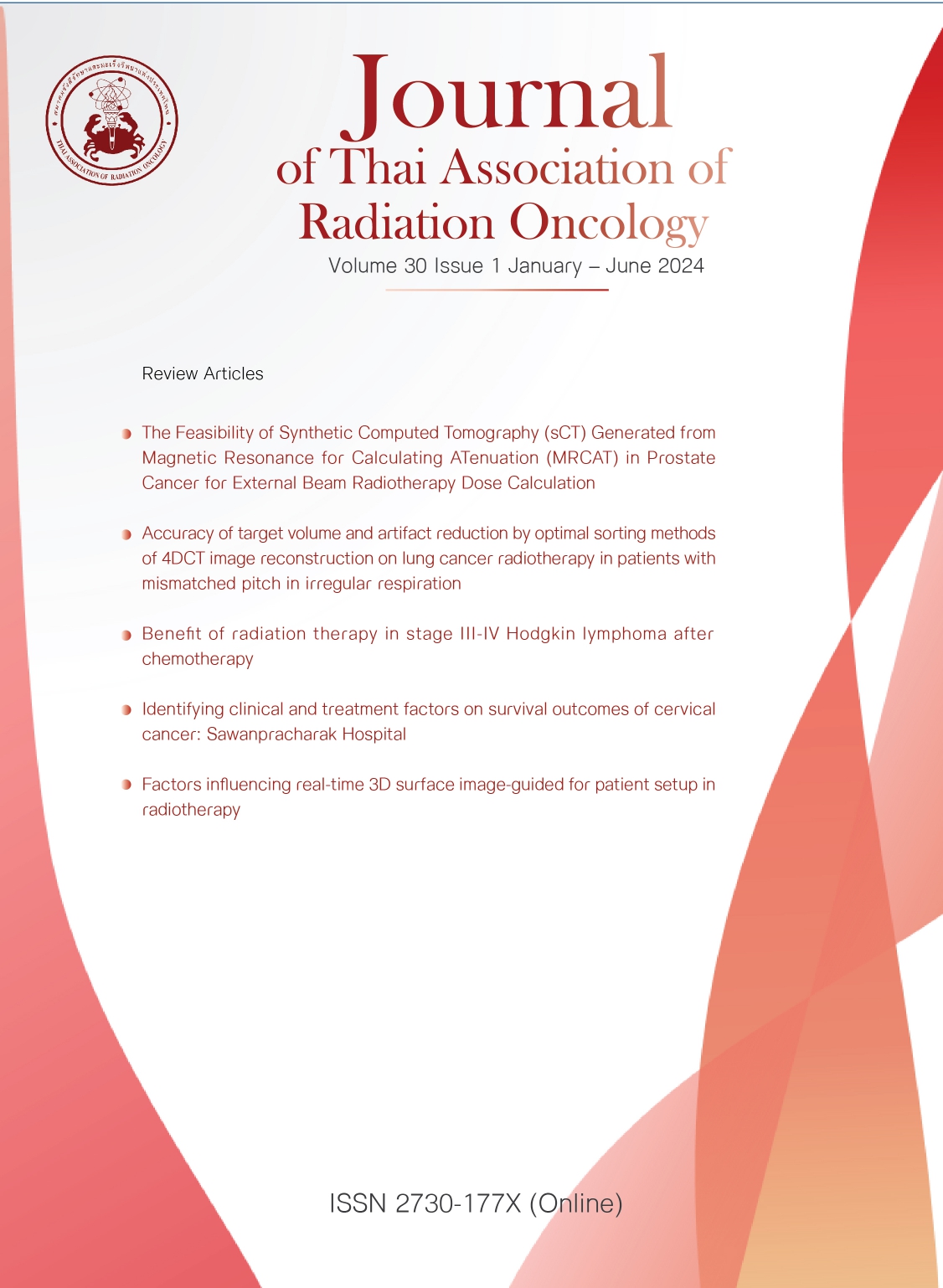Accuracy of target volume and artifact reduction by optimal sorting methods of 4DCT image reconstruction on lung cancer radiotherapy in patients with mismatched pitch in irregular respiration
Keywords:
Artifact, Four-dimensional computed tomography, Salvage radiotherapy, Sorting, Tumor volumeAbstract
Backgrounds: In four-dimensional computed tomography (4DCT), pitch estimates are initially selected before data acquisition. However, during data acquisition, it is observed that pitch values mismatch with the breathing period due to respiratory changes, leading to image artifacts. Addressing this issue requires the selection of an appropriate sorting method, especially for a group of patients in such cases who lack a standardized sorting protocol.
Objective: The study aims to determine the optimal 4DCT scan sorting method for patients with a set-up pitch not aligned with breathing period.
Materials and methods: The respiratory waveforms of 40 lung cancer patients were programmed into the CIRS dynamic thorax phantom, and data were acquired using a CT scanner. Subsequently, 4DCT scans were performed, and the appropriateness of the pitch values, which were set according to standard protocols, was assessed. Three sorting methods, namely phase-based, amplitude-based, and percent Pi-based, were evaluated for their impact on volume accuracy, shape, and the presence of artifacts on 4DCT image in terms of absolute volume difference (AVD), sphericity, and artifact score, respectively, specifically in six subjects with inappropriate parameter settings for acquisition data.
Results: Among the 40 patients studied, six respiratory waveforms had improper parameter settings. The volume of a spherical object for the respiratory phases of 0% and 50% showed similarities to the static volume in all three sorting methods, resulting in an AVD range of 0.18-0.29 cm3. The sphericity values of the three sorting methods with phases of 0% and 50% exhibited variations ranging from 0.001 to 0.003, and the artifacts exhibited a severity level close to 2. Therefore, the study recommended using the images at the 0% and 50% respiratory phase with all sorting methods for target contouring images in clinical practice, as they closely matched the static volume. The findings emphasize the importance of aligning pitch values with the breathing period during data acquisition to maintain image quality.
Conclusion: In patients with irregular breathing amplitude and a mismatch in respiratory rate and breathing period, phase-based or percent Pi-based sorting methods were preferably used for 4DCT reconstructions.
References
Pan T. Comparison of helical and cine acquisitions for 4D-CT imaging with multislice CT. 2005;32:627-34.
Caines R, Sisson NK, Rowbottom CG. 4DCT and VMAT for lung patients with irregular breathing. J Appl Clin Med Phys 2022;23:e13453.
Hilgers G, Nuver T, Minken ACMP. Helical 4D CT pitch management for the Brilliance CT Big Bore in clinical practice. J Appl Clin Med Phys 2015;16:389-98.
Keall PJ, Starkschall G, Shukla H, Forster KM, Ortiz V, Stevens C, et al. Acquiring 4D thoracic CT scans using a multislice helical method. Phys in Med 2004;49:2053-67.
Werner R, Hofmann C, Mücke E, Gauer T. Reduction of breathing irregularity-related motion artifacts in low-pitch spiral 4D CT by optimized projection binning. J Radia Oncol 2017;12:1-8.
Werner R, Sentker T, Madesta F, Gauer T, Hofmann C. Intelligent 4D CT sequence scanning (i4DCT): concept and performance evaluation. Med Phys 2019;46:3462-74.
Rietzel E, Chen GT. Improving retrospective sorting of 4D computed tomography data. Med Phys 2006;33:377-9.
Li R, Lewis JH, Cervino LI, Jiang SB, Biology. 4D CT sorting based on patient internal anatomy. Phys Med Biol 2009;54:4821-33.
Freislederer P, Heinz C, von Zimmermann H, Gerum S, Roeder F, Reiner M, et al. Clinical workflow optimization to improve 4DCT reconstruction for Toshiba Aquilion CT scanners. Z Med Phys 2018;28:88-95.
Pollock S, O’Brien R, Makhija K, Hegi-Johnson F, Ludbrook J, Rezo A, et al. Audiovisual biofeedback breathing guidance for lung cancer patients receiving radiotherapy: a multi-institutional phase II randomised clinical trial. BMC cancer 2015;15:1-8.
Keall PJ, Starkschall G, Shukla H, Forster KM, Ortiz V, Stevens C, et al. Acquiring 4D thoracic CT scans using a multislice helical method. Phys Med Biol 2004;49:2053-67.
Wink N, Panknin C, Solberg TD. Phase versus amplitude sorting of 4D‐CT data. J Appl Clin Med Phys 2006;7:77-85.
Wikipedia contributors. Sphericity: Wikipedia, The Free Encyclopedia.; [updated 21 October 2023; cited 2022 12 October 2022]. Available from: https://en.wikipedia.org/w/index.php?title=Sphericity&oldid=1177772003.
Zheng J, Hryciw RD. Traditional soil particle sphericity, roundness and surface roughness by computational geometry. Geotechnique 2015;65:494-506.
Li H, Noel C, Garcia‐Ramirez J, Low D, Bradley J, Robinson C, et al. Clinical evaluations of an amplitude‐based binning algorithm for 4DCT reconstruction in radiation therapy. Med Phys 2012;39:922-32.
Downloads
Published
How to Cite
Issue
Section
License
Copyright (c) 2024 Thai Association of Radiation Oncology

This work is licensed under a Creative Commons Attribution-NonCommercial-NoDerivatives 4.0 International License.
บทความที่ได้รับการตีพิมพ์เป็นลิขสิทธิ์ของวารสารมะเร็งวิวัฒน์ ข้อความที่ปรากฏในบทความแต่ละเรื่องในวารสารวิชาการเล่มนี้เป็นความคิดเห็นส่วนตัวของผู้เขียนแต่ละท่านไม่เกี่ยวข้องกับ และบุคคลากรท่านอื่น ๆ ใน สมาคมฯ แต่อย่างใด ความรับผิดชอบองค์ประกอบทั้งหมดของบทความแต่ละเรื่องเป็นของผู้เขียนแต่ละท่าน หากมีความผิดพลาดใดๆ ผู้เขียนแต่ละท่านจะรับผิดชอบบทความของตนเองแต่ผู้เดียว




